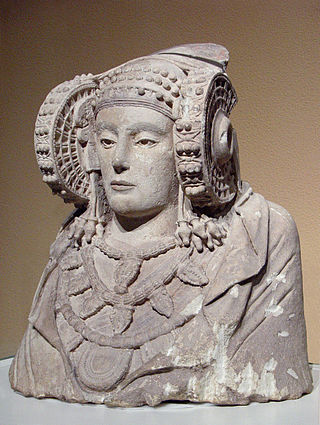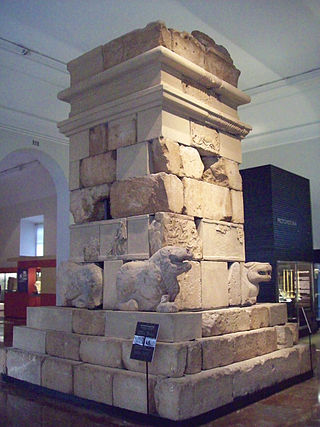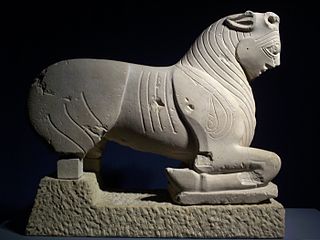
Alfonso V, called the Noble, was King of León from 999 to 1028. Like other kings of León, he used the title emperor to assert his standing among the Christian rulers of Spain. He succeeded his father, Bermudo II, in 999. His mother Elvira García and count Menendo González, who raised him in Galicia, acted as his co-regents. Upon the count's death in 1008, Alfonso ruled on his own.

The Iberians were an ancient people settled in the eastern and southern coasts of the Iberian peninsula, at least from the 6th century BC. They are described in Greek and Roman sources. Roman sources also use the term Hispani to refer to the Iberians.

The Lady of Elche is a limestone bust that was discovered in 1897, at La Alcudia, an archaeological site on a private estate two kilometers south of Elche, Spain. It is now exhibited in the National Archaeological Museum of Spain in Madrid.

The Lady of Baza is a famous example of Iberian sculpture by the Bastetani. It is a limestone female figure with traces of painted detail in a stuccoed surface. It is held in Spain's National Archaeological Museum.

The Punic religion, Carthaginian religion, or Western Phoenician religion in the western Mediterranean was a direct continuation of the Phoenician variety of the polytheistic ancient Canaanite religion. However, significant local differences developed over the centuries following the foundation of Carthage and other Punic communities elsewhere in North Africa, southern Spain, Sardinia, western Sicily, and Malta from the ninth century BC onward. After the conquest of these regions by the Roman Republic in the third and second centuries BC, Punic religious practices continued, surviving until the fourth century AD in some cases. As with most cultures of the ancient Mediterranean, Punic religion suffused their society and there was no stark distinction between religious and secular spheres. Sources on Punic religion are poor. There are no surviving literary sources and Punic religion is primarily reconstructed from inscriptions and archaeological evidence. An important sacred space in Punic religion appears to have been the large open air sanctuaries known as tophets in modern scholarship, in which urns containing the cremated bones of infants and animals were buried. There is a long-running scholarly debate about whether child sacrifice occurred at these locations, as suggested by Greco-Roman and biblical sources.

The National Archaeological Museum is a museum in Madrid, Spain. It is located on Calle de Serrano beside the Plaza de Colón, sharing its building with the National Library of Spain.

Carthaginian Iberia was a province of the larger Carthaginian Empire. The Carthaginians conquered the Mediterranean part of Iberia and remained there until the 2nd Punic war and the Roman conquest of the peninsula.

Lady of Cerro de los Santos, also known as Gran Dama Oferente, is an Iberian sculpture from the 2nd century BCE, that is now in National Archaeological Museum in Madrid.

Lady of Galera is an alabaster female figurine, made in the 7th century BC, that probably represents the Near Eastern goddess Astarte. It is at the National Archaeological Museum of Spain, in Madrid.

Lady of Guardamar, is a limestone female bust, 50 centimetres (20 in) high, dated c. 400-370 BC, that was discovered in fragments in the Phoenician archaeological site of Cabezo Lucero in Guardamar del Segura in Alicante province, Spain, on September 22, 1987.

The Sphinx of Agost is a Greek-influenced Iberian limestone sculpture, dated from the late 6th-century BCE, that was found in the Agost reservoir in Alicante, Spain, in 1893.

Iberian sculpture, a subset of Iberian art, describes the various sculptural styles developed by the Iberians from the Bronze Age up to the Roman conquest. For this reason it is sometimes described as Pre-Roman Iberian sculpture.

Galera is a municipality in the comarca of Huéscar, province of Granada, autonomous community of Andalusia, Spain. It is situated in a sparsely populated area roughly 150 kilometres (93 mi) from the provincial capital, Granada.

The Roca dels Moros or Caves of El Cogul is a rock shelter containing paintings of prehistoric Levantine rock art and Iberian schematic art. The site is in El Cogul, in the autonomous community of Catalonia, Spain. Since 1998 the paintings have been protected as part of the Rock art of the Iberian Mediterranean Basin, a UNESCO World Heritage Site. Inscriptions in Northeastern Iberian script and in Latin alphabet indicate that the place was used as a sanctuary into Iberian and Roman times.

Cancho Roano is an archaeological site located in the municipality of Zalamea de la Serena, in the province of Badajoz, Spain. It is located three miles from Zalamea de la Serena in the direction of Quintana de la Serena Quintana, in a small valley along the stream Cagancha.

The Exaltation of the Flower is the modern title given to an early Classical Greek marble fragment of a funerary stele from the 5th century BCE. It was discovered in 1861 by Léon Heuzey and Honoré Daumet at a church in Farsala, Thessaly, Greece. Carved in bas-relief in the severe style, the extant upper fragment of the marble relief stele depicts two women holding what appear to be flowers or other objects. The work is held by the Louvre museum in the Department of Greek, Etruscan, and Roman Antiquities.

The Mausoleum of Pozo Moro is a Mausoleum of the Iberians from the end of the 6th century BC, which was discovered in 1970 in excavations made in the Province of Albacete.

Cerro de los Santos is an Iberian religious sanctuary built in the 4th century BCE, during the Iberian period, with evidence of continued use into the Roman period. The site lies in southeastern Spain near an ancient road. Little remains of the original structures at the site. Nineteenth century excavations documented some features of a temple but only an outline now remains. The site is known for its many votive sculptures, numbering about 300. Most of the sculptures depict women including the most notable find, the Dama del Cerro de los Santos. In addition to the women, statues of men, possibly dating from a later period, and a few statues of animals have also been found.

The history of ancient Iberian coinage begins as early as the fifth century BC, but widespread minting and circulation in the Iberian peninsula did not begin until late in the third century, during the Second Punic War. Civic coinages - emissions made by individual cities at their own volition - continued under the first two and a half centuries of Roman control until ending in the mid-first century AD. Some non-civic coins were minted on behalf of Roman emperors during this period and continued to be minted after the cessation of the civic coinages. After the cessation of the civic coinages, these Imperial coins were the only coins minted in Iberia until the coins of the Suebi and Visigoths.

The Toritoof Porcuna is an Iberian sculpture depicting a bull. It shows orientalizing influences and it is also referred to as the toro orientalizante de Porcuna.























